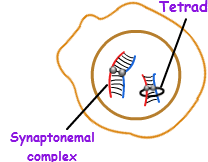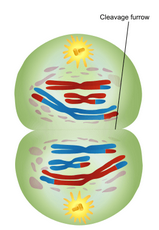MEIOSIS
$\displaystyle \small \bullet$ Meiosis occurs in the reproductive cell or in germ cells during gametogenesis.
$\displaystyle \small \bullet$ During meiosis, a diploid cell undergoes two successive division and produce four daughter cells
$\displaystyle \small \bullet$ The daughter cells contain only half the number of chromosomes of parent cell, hence it is a reductional division
$\displaystyle \small \bullet$ Meiosis involves two successive divisions: meiosis-I and meiosis-II
$\displaystyle \small \bullet$ Meiosis I has four phases:
Prophase I, Metaphase I, Anaphase I, Telophase I
$\displaystyle \small \bullet$ Meiosis-II has four phases:
Prophase II, Metaphase II, Anaphase II, Telophase II
MEIOSIS I
Prophase I
Prophase-I is divided into 5 sub stages:
Leptotene
$\displaystyle \small \bullet$ Chromosomes are shortened and are visible as single strand
$\displaystyle \small \bullet$ Chromosomes appear like beaded due to chromomeres
$\displaystyle \small \bullet$ Compaction or condensation of chromosomes continues throughout leptotene
$\displaystyle \small \bullet$ All chromosomes are attached to common point of nuclear membrane called bouquet structures

$\displaystyle \small \bullet$ Homologous chromosomes get paired
$\displaystyle \small \bullet$ Paired homologous chromosomes seen as bivalents or tetrad
$\displaystyle \small \bullet$ The pairing process is called synapse. The complex structure that forms the synapsis is called synaptonemal complex
$\displaystyle \small \bullet$ Chromosomes become short and thick by the condensation

$\displaystyle \small \bullet$ Crossing over occurs between non-sister chormatids of homologous chromosomes
$\displaystyle \small \bullet$ Paired homologous chromosomes become twisted and appear as tetrads
$\displaystyle \small \bullet$ Crossing over is the exchange of genetic material between the two homologous chromosomes
$\displaystyle \small \bullet$ The crossing over is called chiasma formation. It is an enzyme mediated process and is catalysed by recombinase enzyme
$\displaystyle \small \bullet$ Recombination between homologous chromosomes is completed by the end of pachytene, leaving the chromosomes linked at the sites of crossing over
$\displaystyle \small \bullet$ Exchange of corresponding chromatid segment, nucleoli disappears

$\displaystyle \small \bullet$ Synaptonemal complex dissolves and bivalents separates each other except the region of crossing over
$\displaystyle \small \bullet$ Chromosomes appear like X-shaped
$\displaystyle \small \bullet$ Bivalents repel each other
$\displaystyle \small \bullet$ Chromosomes joined at several points along their length called chaisma, which is at the site of crossing over

$\displaystyle \small \bullet$ This is the last stage of prophase-I
$\displaystyle \small \bullet$ Terminalisation of chiasma occurs
$\displaystyle \small \bullet$ Further repulsion of bivalents and homologous chromosomes start moving towards equator
$\displaystyle \small \bullet$ Nuclear membrane disappears
$\displaystyle \small \bullet$ Centrioles migrate to poles
$\displaystyle \small \bullet$ Formation of spindle fibres

Metaphase I
$\displaystyle \small \bullet$ Bivalent chromosomes are aligned at equatorial plate of the spindle
$\displaystyle \small \bullet$ Arms of chromatids pointed inwards and centromere pointed towards the poles
$\displaystyle \small \bullet$ Bivalents are attached at the centromeres to the spindles
$\displaystyle \small \bullet$ Reduction of chromosome number takes place in metaphase-I

$\displaystyle \small \bullet$ Spindle fibres pull the chromosome, homologous chromosomes separate while sister chromatids remain associated
$\displaystyle \small \bullet$ No splitting of centromere
$\displaystyle \small \bullet$ Separated chromosomes move towards opposite poles
$\displaystyle \small \bullet$ Shrinking of spindle fibres

Telophase I
$\displaystyle \small \bullet$ Each pole receives haploid set of chromosome and they are composed of two chromatids
$\displaystyle \small \bullet$ Due to crossing over chromatids are not genetically identical
$\displaystyle \small \bullet$ Spindle fibres disappears
$\displaystyle \small \bullet$ The chromatids uncoil and forms chromatin network
$\displaystyle \small \bullet$ Nuclear membrane is formed
$\displaystyle \small \bullet$ Nucleolus reappears
$\displaystyle \small \bullet$ Cytokinesis forms two cells

MEIOSIS II
$\displaystyle \small \bullet$ Meiosis II is initiated immediately after cytokinesis, usually before the chromosomes have fully elongated. In contrast to meiosis I, meiosis II resembles a normal mitosis.

Prophase II
$\displaystyle \small \bullet$ The nuclear membrane disappears by the end of prophase II. Nucleoli disappears
$\displaystyle \small \bullet$ The chromosomes again become compact, they become short, thick and are clearly visible
$\displaystyle \small \bullet$ Centrioles start to move towards opposite pole
$\displaystyle \small \bullet$ Appearance of spindle fibres
Metaphase II
$\displaystyle \small \bullet$ At this stage the chromosomes are arranged at the equatorial plate
$\displaystyle \small \bullet$ The microtubules from opposite poles of the spindle get attached to the kinetochores of sister chromatids
$\displaystyle \small \bullet$ Nuclear membrane and nucleoli are absent
Anaphase II
$\displaystyle \small \bullet$ It begins with the simultaneous splitting of the centromere of each chromosome, allowing them to move toward opposite poles of the cell
$\displaystyle \small \bullet$ Spindle fibres are shortened and pulls the centromere towards pole
$\displaystyle \small \bullet$ Centromere is divided and chromatid move to opposite poles
$\displaystyle \small \bullet$ Separated chromatids are now called chromosomes
Telophase II
$\displaystyle \small \bullet$ Chromatids get uncoil and forms chromatin network
$\displaystyle \small \bullet$ Nuclear membrane and nucleolus reformed
$\displaystyle \small \bullet$ Cytokinesis follows resulting in the formation of four haploid daughter cells
SIGNIFICANCE OF MEIOSIS
$\displaystyle \small \bullet$ Restoration of original chromosome numbers: the reductional division forms haploid cell or gametes. The fusion of such haploid cells restores the chromosomal number
$\displaystyle \small \bullet$ Variations : the crossing over during meiosis forms different genetic constitution. It leads into variations in the offsprings
$\displaystyle \small \bullet$ Meiosis is the mechanism by which conservation of specific chromosome number of each species is achieved across generations in sexually reproducing organisms
$\displaystyle \small \bullet$ It also increases the genetic variability in the population of organisms from one generation to the next
$\displaystyle \small \bullet$ Variations are very important for the process of evolution



0 Comments